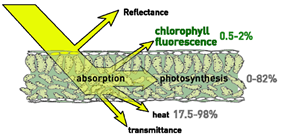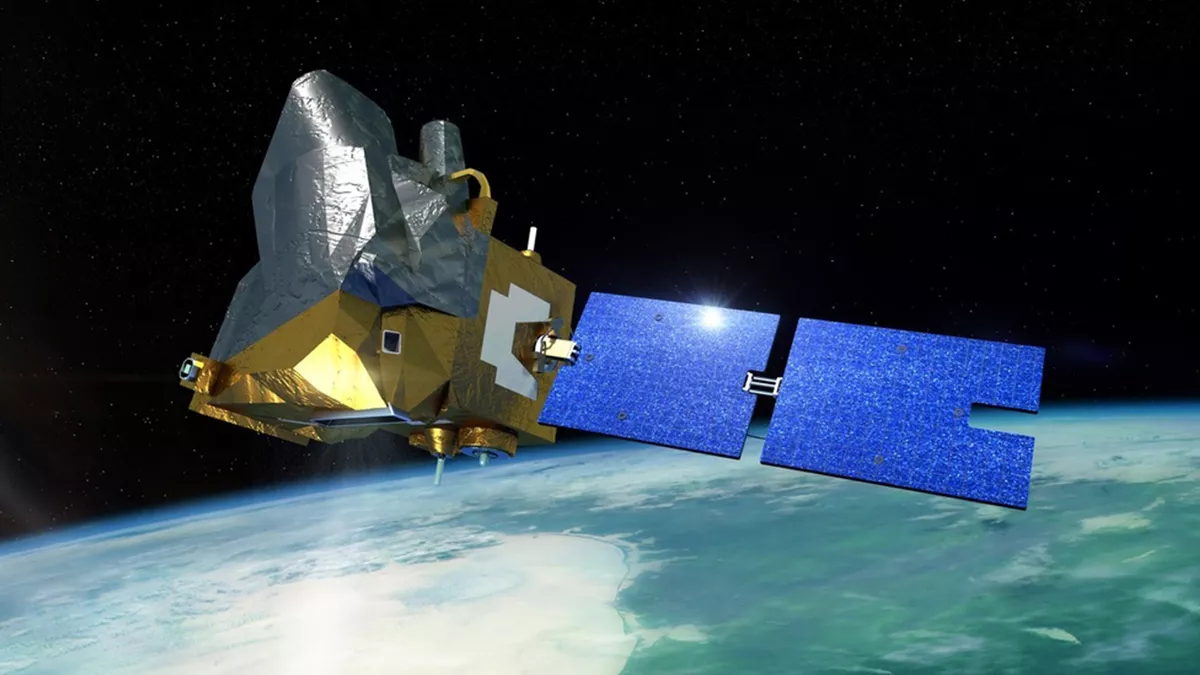
News and Media

Solar induced fluorescence (SIF) – Observing the subtle glow of plants from space to better understand the carbon cycle

Plants emit a faint, infrared glow as a by-product of photosynthesis, known as solar induced fluorescence (SIF). This signal can be detected from space using spectrometers onboard Earth-orbiting satellites. SIF serves as a valuable proxy for photosynthetic activity, offering crucial insights into the global carbon cycle. It is also an important indicator of plant health and can support crop monitoring and drought risk assessment.
The SIF process
Approximately 80% of absorbed solar radiation by plants is utilised to store carbon via photosynthesis, the remainder of which is dissipated through radiation and other processes. Part of this dissipated energy is released in the form of infrared radiation (0.5-2.0%), more commonly referred to as SIF.
Approximately 80% of the sunlight absorbed by plants is used by the photosynthesis process – by which plants convert light energy into chemical energy to grow and store carbon. However, not all the absorbed energy can be used this way, especially when there is more light than the plant can handle at a given time.
The remaining energy, roughly 20%, is dissipated through non-photochemical processes, such as chlorophyll fluorescence, heat dissipation, and energy transfer to other molecules. A small fraction of this dissipated energy, typically about 0.5-2.0%, is emitted as SIF, predominantly in the near-infrared (NIR) region, between 650 and 800 nm.

SIF is part of a natural response that helps protect plants from damage caused by absorbing too much light. It works alongside other ways plants stay safe, like releasing extra energy as heat or using chemical changes to deal with stress.
Why is SIF important?
Photosynthesis enables plants to convert sunlight into chemical energy while removing carbon dioxide from the atmosphere and storing it in biomass. Scientists refer to the total amount of carbon captured by plants through this process as Gross Primary Production (GPP) – a key indicator of how much carbon vegetation is drawing down from the atmosphere.
A major challenge is that GPP cannot be measured directly from space, largely because carbon uptake through photosynthesis overlaps spatially and temporally with carbon release through plant respiration. While GPP can be estimated at small scales using techniques like eddy covariance, these ground-based methods lack the coverage needed to monitor vegetation over vast and varied landscapes.
This is where SIF becomes valuable. Because SIF is closely tied to photosynthetic activity, it can act as a proxy for GPP, allowing scientists to estimate carbon uptake using a scaling factor that varies depending on vegetation type and environmental conditions.
In addition, SIF is increasingly being used to improve land surface models—tools that simulate the movement of carbon, water, and energy through ecosystems. These models are critical for understanding climate change, predicting droughts, and guiding land use planning. Incorporating SIF data from satellites helps constrain and refine these models, especially in estimating natural carbon fluxes more accurately.
Beyond climate applications, SIF also has many practical uses. It can act as an early warning system for plant stress, helping to identify drought or heatwave risks before visible symptoms appear. In agriculture, SIF is used for crop monitoring and yield forecasting, supporting precision farming and food security.
Uses of Solar-Induced Fluorescence (SIF)
- In satellite-based Earth observation – Instruments on missions like JAXA’s GOSAT and GOSAT-2, NASA’s OCO-2, ESA’s Sentinel-5P, and the upcoming MicroCarb and FLEX missions can detect SIF from space.
- To monitor vegetation dynamics – SIF can be used to track seasonal growth and phenological changes.
- As an indicator of plant stress – Changes in SIF can reveal physiological stress before visible symptoms appear, such as from heat, drought, or disease.
- As a proxy for photosynthetic activity – SIF allows indirect estimation of carbon assimilation, as it indicates how efficiently plants use absorbed light for photosynthesis.
- For crop health monitoring and yield estimation – SIF correlates with crop productivity and can support precision agriculture and food security forecasting.
- For early warning of flash droughts – Reductions in SIF can serve as a rapid indicator of water stress, providing early alerts before other metrics respond.
- To improve carbon cycle and climate models – SIF data helps estimate vegetation carbon uptake, reducing uncertainty in land surface models and Earth system models.
- To assess recovery after disturbances – SIF can help evaluate how vegetation recovers after events like fire, logging, or extreme weather.
The Role of SIF in the MicroCarb Satellite Mission
To accurately measure atmospheric CO₂ concentrations from space, it is essential to account for all sources of upwelling radiation at the top of the atmosphere. One of these sources is SIF. Although small, the SIF signal overlaps spectrally with the bands used to detect CO₂, meaning it must be accounted for in the CO₂ retrieval process to avoid bias in the final measurements.
The University of Leicester has developed a dedicated SIF retrieval algorithm for the MicroCarb satellite mission, which will be implemented as part of the mission’s central processing chain. In addition to supporting accurate CO₂ estimates, this algorithm will also produce a standalone SIF product with strong potential for scientific applications.
The MicroCarb SIF dataset will contribute to carbon cycle science by offering an additional measure of photosynthetic activity, with high spatial resolution and a unique observation time. This provides new opportunities to study sub-diurnal variations in SIF, helping researchers understand how vegetation responds to incident solar radiation and environmental stress throughout the day.
Publications
Peter Somkuti et. al (2020) – https://doi.org/10.1016/j.agrformet.2019.107826
University of Leicester GOSAT-SIF product – https://dx.doi.org/10.5285/edd6991e06024f7d9ee06460ec7cd7f6
Share this article



Published by Fazila Patel
Digital Comms Officer
University of Leicester

Latest News and Events




